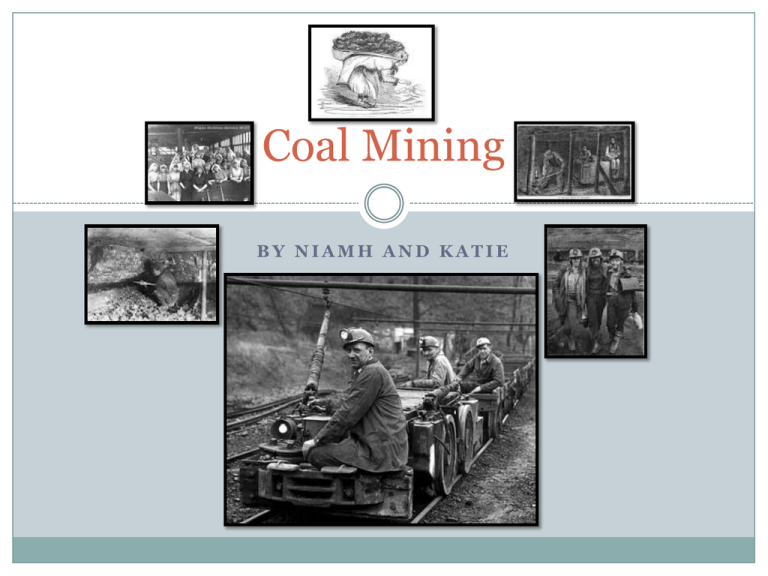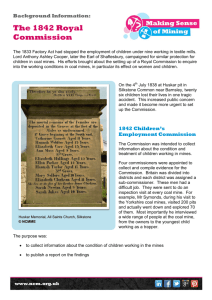Coal Mining - TarbertHistory
advertisement

Coal Mining BY NIAMH AND KATIE Coal mining has existed in Scotland since the 12th century (1100’s) Davy Safety Lamp detected poisonous gases by its flame changing colour. There were many technical advances before 1830: The Davy Safety Lamp was devised in 1815 and saved thousands of lives Ventilation=Fire buckets to draw fresh air through the pit Watts Steam Engine pumped water out of the mine. Gunpowder and fuse helped get to coal easier. Mining Before 1830 Reasons for Increased Demand When James Watt invented the Steam Train in the 18th century it increased the demand for coal In the 19th century the demand for coal increased further because of railway development had to be dug deeper Mines More Reasons As the population of towns grew, many people used coal to heat their homes and cook food Coal was used in production for street and house lighting Iron industry used coal for smelting Types Of Mine Bell Pit Drift Mine Types Of Mines Spiral Pit Trap Pit Types of Jobs Trappers Hewers The youngest children Men/older boys who (4-5) opened and shut traps on the air doors of the mines to keep air clean. cut coal away from coal face using pick axes. More Jobs Bearers Boys/girls who dragged or pushed coal in carts to bottom of pit shaft. Or carried loads up the shaft on their backs in baskets called creels. Working conditions before 1842 There was a huge increase in demand for coal for industrial and domestic needs There were long working hours (around 12 hours a day, 6 days a week) but workers were still paid poorly even though they faced many dangers: Choke damp 2. Flooding 3. Coal dust Silicosis 4. Explosions 1. 1842 Mine Act In 1840, the government set up a Royal Commission to investigate conditions underground. In 1842, its report was published. The Mine Act was then published: No females to be employed underground 2. No boys under the age of 10 to be employed 3. Boys under 15 not to operate winding gear 4. Inspectors to be appointed t0 enforce the act 1. Aftermath Of The Report Even though many mines ignored the act it was a step in the right direction For the first time, the government had passed a law that was eventually to result in improved working conditions in the mines. The Mines Act How Conditions Changed Early 1800’s conditions Late 1800’s conditions Technology: Technology 1. 2. 3. 4. 5. Wooden Props Buckets for drainage Candles/Safety lamp Picks for cutting Gunpowder with fuse 1. 2. 3. 4. 5. Metal Props Steam Driven Pumps Electricity Electric digging tools Gelignite with detonator W0rld War One When the war started there was a huge impact on the coal industry By July 1915 the output of coal was down by 3 million tons due to workers joining the army With fewer miners, owners had to do something they attempted to increase working hours which was resisted by the miners. So without enough workers it was a big problem! To run factories Power Railways In February 1917 the government decided IT would control the mines for the duration of the war. This is called NATIONALISATION. This also stopped anymore miners joining the army. Iron Works (weapons) Coal & WW1 Fuel Homes Coal was needed for… Run Ships In many cases wages were higher than before, mining was just as important as the troops in France Trouble heightened in the 1920s when owners tried to reduce pay and increase working hours. But miners went on strike… ‘’Not a penny off the pay not a minute on the day’’ In years after the war a law was passed for Safety and conditions: Hours reduced to 7 a day Pithead baths were introduced But there were still a few problems… Improvements Cheap coal was coming from Poland and Germany so less coal was being exported The coal industry has never regained itself since. A graph of coal mining production from 1700>





